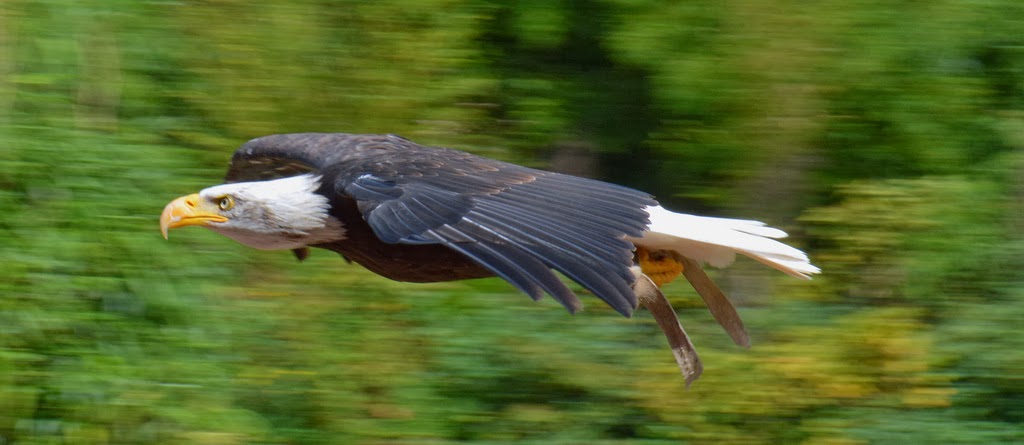Camera shake and inaccurate focus are the major reasons that cause soft or blurry images when photographing birds in flight. While camera shake could be handled by using image stabilized lenses, shooting at higher speeds and by better stabilizing the camera, achieving accurate focus consistently requires the use of right focusing technique and a lot of practice.
 |
| Photo by: Andy Morffew |
Modern DSLR cameras and lenses with advanced auto focus features greatly increase the number of accurately focused images. However to make the most out of these technological advancements, one must fine tune his/her shooting technique to perfection.
Tips for Acquiring Fast, Accurate Focus Consistently
Best Focusing Technique:- Focus manually and then let Auto Focus kick in and lock on to Target.
 |
| Photo by: Ken Slade |
There is a reason why most advanced lenses feature a full time manual focus feature (it lets you focus manually even if the lens is set to AF mode). Most lenses perform well and lock on to a subject in a fraction of a second if the subject is almost in focus.
For example:
If you are trying to focus on a bird flying about 25 meters away with your lens pre-focused to say 20 – 30 meters range, the lens will attain focus very fast. As the lens only need to search a small distance and not go through its entire range to find the subject. However if you try to focus the same bird which is 25 meters away when your lens focus is set to 5 meters chances are the lens will take a really long time searching the entire range and by the time the bird will be long gone.
You might have experienced this when you take a picture of some nearby object and then try to shoot something which is very far.
 |
| Photo by: Irene Grassi |
The trick to overcome this issue is to focus manually on the bird, you need not try to attain exact sharp focus, but focus on the general direction of the bird and then let the auto focus do the rest of the job of fine tuning the focus and locking on to the subject. So do the major focus changes manually and let auto focus do the micro adjustments needed. This technique works all the time with all sorts of equipment; from the most basic of zoom lenses and camera bodies to the most advanced gear ever produced.
Focus Limiter
Many of the modern lenses allow the photographer to limit the range of focus. They have a button dedicated to this usually called the Focus Limiter.
Most cameras when they can't lock on focus will have the lens search through the range of focus distances until some detail is detected; this is sometimes called "hunting". A focus limiter simply restricts the range of distances the camera will attempt to focus at. Because auto-focus isn’t very good at quickly searching the entire focal range for the subject, limiting the focus range improves both the speed of focus and the accuracy (assuming you are only interested in subjects within the range you have selected).
For example:
If you are shooting birds that are very far away from your position, you can safely set the focus limiter to ignore the closer range and thus improve the auto focus speed and accuracy.
However photographers are divided in their opinion whether it is a useful feature or not. There is no doubt that limiting focusing range will improve focusing speed and accuracy in the set range. But there are a couple of drawbacks to this approach.
 |
| Photo by: Tambako The Jaguar |
Firstly if you use your lens with focus limiter set to distant focus, say 20 meters to infinity. You will find yourselves helpless if a bird suddenly moves/lands very close to you or flies towards you. Unless you are not able to quickly locate the focus limiter button and switch it to focus at full range, your lens will not be able to lock focus and you will miss the shot.
 |
| Photo by: Tambako The Jaguar |
Secondly letting the lens do the range searching and finding the bird in the scene is not the ideal way to focus quickly on birds. Searching the entire focal range is not what lenses do best, instead as we mentioned earlier in this article, do the major focusing manually and let the auto focus do the micro adjustments. Adopting this technique not only makes your focusing more fast and accurate but also lets you use your lens with focusing range set to full at all times.
Focus Confirmation Signals
 |
| Photo by: Isidro Vila Verde |
Most cameras give two types of focus confirmation signals, one visual and the other audible. The focus confirmation light in the viewfinder will give a visual confirmation while a beep sound will give you an audible confirmation. Wildlife photographers are often advised to turn off the beep sound as it is an artificial sound and can easily spook the animals. But in case of bird photography the soft noise will only bother the most shy of birds. Sometimes it could even work to your advantage as the birds when hearing the sound become curious and turn their head in your direction to investigate. So it’s mostly a personal choice, if you find it annoying, or if it seems to alert the birds of your presence turn it off else leave it on.
Related Reading
- How to Photograph Birds in Flight Using Manual Focus Lenses
- How to Photograph Birds of Prey
- Bird Photography Tips
- Tips for Photographing Birds in Flight
- Bird Photography Tips - Getting Close to Birds